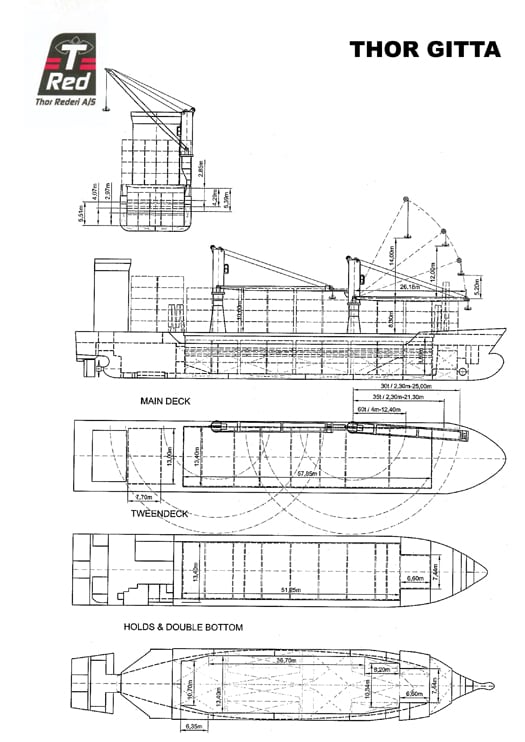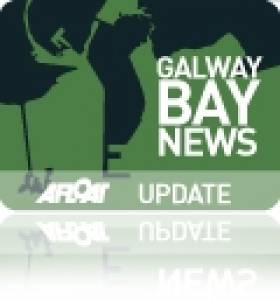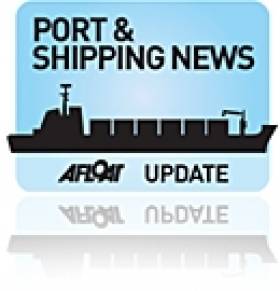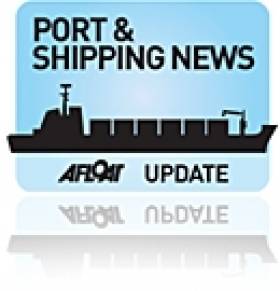Displaying items by tag: Galway Bay and Harbour News
Galwegian Special Olympian Athletes Celebrate On board Navy's Flagship
The world games which were held during June and July saw over 7,500 athletes from 185 countries participate in the Greek capital. Team Ireland in total brought home 107 medals, with athletes from Galway securing 11 medals and a number of ribbons in a variety of sports.
Speaking about the reception, Regional Director Myra Merrick said: "We are honoured to have the Naval Service docking in Galway especially for the function. The athletes deserve a warm reception and recognition for their wonderful success. It's a huge achievement in itself to participate at World Games level, let alone bring back a medal".
"The event presents an exceptional opportunity for the public to extend congratulations to our local sporting heroes, explore the Defence Forces vessel and meet the officers" she added.
The 1984 built /1,910 tonnes 'helicopter patrol vessel' and her seven fleetmates are all each assigned to a particular charity. In the case of L.E. Eithne she is associated with Our Lady's for Sick Children, Crumlin in Dublin.
Mauritius-Bound Ferries Finally Bid Galway Farewell
First to be loaded was the Clann na nOileáin on Wednesday in an operation than took four-hours while on Friday her sister Clann Eagle I took six-hours to be winched safely onto the cargo-deck during freshening winds.
It is ironic that since Thor Gitta 's arrival to the port's Dún Aengus Dock on 5 April that it would also nearly be the same time taken for the estimated 25-day delivery voyage of the ferries to the Indian Ocean island.
During the 8,300 mile journey Thor Gitta will make several port of calls with the first call to La Rochelle. The Bay of Biscay port is the next largest port south of Les Sables d'Olonnes, where the fast-ferries where built at the OCEA boatyard for her original owners Bád Arann Teoranta which traded as Aran Direct on routes from Rossaveal to the islands.
Thor Gitta was built in 1996 and is also designed to carry 364 TEU (twenty-foot equivilant unit) containers and belongs to an-eight strong fleet operated by the Danish company, Thor Rederi A/S of Svendborg.
One of the reasons why the heavylift vessel was delayed in loading was to ensure the correct positioning of the ferries so not to further disrupt other port call cargo allocation while on the long repositioning voyage to Mauritius.
The 4,078 tonnes cargsoship is also scheduled to make en-route calls to Pointe Noir in the Congo, Cape Town and Pemba in Mozambique before finally reaching the southern Indian Ocean destination.
When the ferries were completed in 2005 and 2006 they were valued between €5-6m but they only served up to September 2008 when the 243 passenger aluminium built craft were laid-up at the Connemara harbour due to financial difficulities.
This led to the company going into receivership and the vessels were put up for auction in Galway last February. Despite bids reaching €950,000, they were withdrawn at the auction hosted by the Cork based auctioneer, Dominic J. Daly.
In the following month the fast-ferries were sold to the French owner for a new career based from the island state which is in the Mascarene Islands. Mauritius is neighboured by the smaller islands of Agalega, Cargados Carajos, Rodrigues and the French island of Réunion some 200km to the southwest.
Good Friday in Galway as Second Ferry is Loaded
Despite freshening winds the 169 gross registered tonnes ferry was winched out of the waters of the port's Dún Aengus Dock. In total the operation took six-hours which saw the delicate positioning of the 27m long ferry between the ship's two deck-mounted cranes and lowered onto the cargo-deck.
Yesterday proceedings to load the ferry were suspended due to delays in relocating other cargo so to accommodate the 243 passenger capacity ferry. This followed the loading of her sister Clann na nOileáin on Wednesday.
Several previous attempts to hoist the Clann Eagle I onto the deck of the Danish-flagged vessel have been hampered. At one stage due to complications in efforts to transport the vessels, the 100m Thor Gitta was temporary detained by the admiralty marshal.
Procedures to load the 29 knots fast-ferry pair have been beset with incidents notably the grounding and subsequent damage to the first chartered cargoship, Patanal, off Rossaveal. It was originally planned to sail the ferries out into Casla Bay where the German-flagged vessel would load them onboard.
As a consequence the ferries were transferred to Galway where the Clann na nOileáin did not escape attention either. On the first attempt to load the ferry one of the ship's slings snapped from the crane-cradle causing the 172 tonnes ferry to fall into the water.
Minor damage was caused to the ferry, though three men who remained onboard at the time of the incident were taken to hospital but were later released.
Last month the ferries were sold to a French buyer after the company that owned them Bád Arann Teoranta (trading as Aran Direct) went into receivership. The ferries operated on several routes between Rossaveal to the islands but are now destined to serve on an inter-island service from the Indian Ocean island.
Ferry-Tales of the Unexpected Continue in Galway Docks Drama
Despite successfully loading the first ferry, the 172 gross tonnes ferry Clann na nOileain yesterday morning, which took four hours, the time to secure the vessel on the cargoship's deck continued much longer than anticipted.
As a consequence this led to further delays in the the clearance of existing cargo so to enable sufficient space to load the second ferry onboard the Thor Gitta.

The 4,078 gross tonnes heavy-cargo liftship was due to have started loading the second ferry the 169 tonnes ferry Clann Eagle I yesterday afternoon but this has been delayed until 12 noon today.
The Danish-flagged Thor Gitta has been in Galway for over a fortnight. She berthed with her starboard side facing alongside the quay. With this orientation the cargoship's two-deck mounted cranes swing out on the opposite port side which were used to raise the first ferry out of the water on 7 April.
On that ocasion the forward sling snapped causing the Clann na nOileain to plunge into the waters within the port's single dock named the Dun Aengus Dock.
In recent daysThor Gitta has shifted berths which has resulted in the 100m long vessel berthing on her starboard side again next to the dock's quayside. The deck-mounted cranes on the port side continue to face out overlooking the open water of the dock.
The loading of Clann na nOileain is all the more skillfull considering that the 27m length of the ferry had to be hoisted and swung at an angle between the narrow span of the two deck mounted cranes.
For file photos of vessels in loading mode from the Rederi A/S fleet owners of the Thor Gitta click here.
Thor Gitta is the second chartered vessel called in to assist in the transportation of the two former Aran Islands fast-ferries.
The other cargoship, the longer 120 metre Patanal, ran aground at the end of March during stormy seas after dragging its anchor in Casla Bay, at the entrance to Rossaveal harbour. The 7,002 tonnes vessel sought initial repairs before leaving Galway Bay last week for further work in Germany.
The monuhull fast ferry pair were custom built in France for Bad Teoranta (trading as Aran Direct) but the company went into recievership.
At an auction held in Galway last month the vessels did not sale despite bids reaching €950,000, they were withdrawn at the auction. The ferries were later sold for a sum believed to be seven-figures to an operator based in the Indian Ocean island of Mauritius.
First of Two Ferries Loaded in Galway
The Clann na nOileáin was first loaded onboard this morning whereas her sister Clann Eagle I will be hoisted this afterrnoon. It is expected that this procedure will take around four hours to complete.
The 234-passenger ferries have been the centre of attention since two previous attempts proved unsuccessful following incidents in the mid-west port.
On the first attempt that took place nearly a fortnight ago, three men onboard the ferry were injured when the ships's crane-sling snapped when handling the 170 tonnes ferry Clann na nOileáin.
Fortunately the ferry was hanging over the water and splashed into Dun Aengus Dock rather than landing on the hold of the 4,078 gross tonnes cargo-vessel Thor Gitta. In the second attempt last
Saturday one of the cargoship's cranes sounded a safety alarm which halted proceedings.
The Danish-flagged Thor Gitta is the second heavy-lift cargoship that has been called in to assist in transporting the two former Aran Islands fast-ferries. The 100m cargoship is owned by Thor Rederi A/S of Svendborg and is expected to depart Galway tommorrow morning.
The first heavylift vessel the German-flagged Patanal grounded in rough seas after dragging its anchor in Casla Bay at the entrance to Rossaveal, where the ferries were originally based in readiness for loading.
Patanal suffered hull damage and was taken into Galway Bay for preliminary repair work. Last week the 7,002grt vessel operated by Harren + Partners, departed the bay to undergo further repairs at a dry-dock in Bremerhaven.


































































